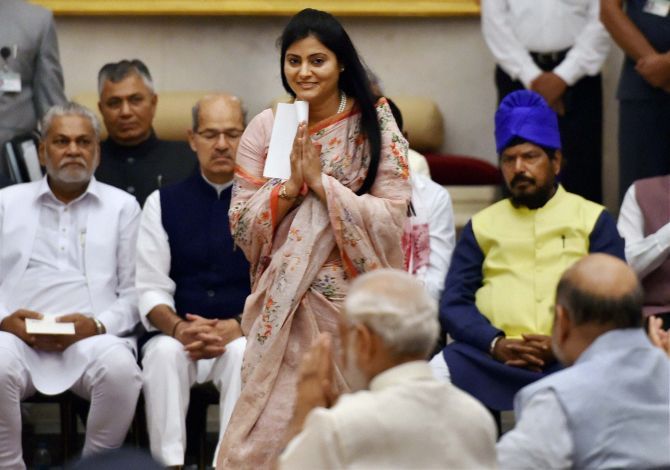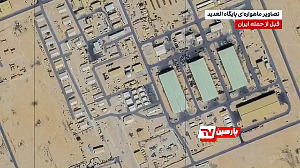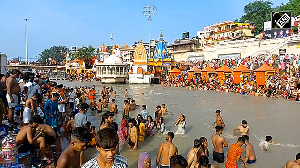In the event of a triangular contest the winning party will need about 40 per cent of the votes polled.
And it is here that the votes of the numerically smaller communities will come into play.

Small is big when it comes to electoral politics in caste-ridden Uttar Pradesh where even a minuscule sub-caste becomes a force to reckon with and lesser known political parties representing them seem to be reaping the benefit.
Come elections, these smaller political outfits make their presence felt in a big way as they can influence the outcome in the high stakes elections this time.
These parties also matter for mainstream political parties like the BJP and Congress because of the support they enjoy among certain castes.
The little known Suheldev Bhartiya Samaj Party is forging an alliance in eastern UP with the BJP, which is also in talks with the Janwadi Party-Socialist, headed by Sanjay Singh Chauhan.
The Apna Dal headed by Union Minister Anupriya Patel is already an NDA ally.
Seeking to leave its mark in cow belt politics, the Peace Party, the Nishad Party and the Mahan Dal are also expected to throw their hats in the ring.
With certain castes and sub-castes likely to leave an imprint on UP politics, it was definitely not out of the blue when Chief Minister Akhilesh Yadav recently cleared the file carrying the names of 17 Other Backward Castes for inclusion in the scheduled castes list.
While Akhilesh sought to score a brownie point by this move, BSP chief Mayawati sought to checkmate him by trashing the decision as nothing but an 'election stunt', though it was her government that had sent the recommendation to the Centre earlier.
The 17 sub-castes which the government wants included in the scheduled castes category are: Kahar, Kashyap, Kewat, Nishad, Bind, Bhar, Prajapati, Rajbhar, Batham, Gauriya, Turha, Majhi, Mallah, Kumhar, Dheemar, Dheewar and Machhua.
Though individually each has a very small vote share, together, they make up a significant chunk of votes.
The OBCs are roughly 44 per cent of UP's electorate, the Dalits 21 per cent, the Muslims 19 per cent, and the upper castes 16 per cent.
Yadavs, the core of the SP's base, are numerically and socially dominant among the OBCs.
But the 200-odd non-Yadav OBCs together account for over double the Yadav population. They include the Kurmis, Koeris, Lodhs, Jats and Sunars, while the Pasis and Valmikis are the large groups among Dalits.
The Peace Party of India won four assembly seats in the 2012 UP assembly polls and plans to forge an alliance with the Nishad Party to contest all the 403 seats.
The PPI has its support base among Muslims and contested 200 seats in 2012 with the Apna Dal as its ally.
The Nishad Party banks on the votes of fishermen in parts of eastern UP where the Nishad community has a sizeable presence.
The Mallah community, which makes up around 4.5 per cent votes, is divided into 27 sub-castes, and has a good presence in roughly 125 constituencies along the rivers in UP, where they contribute to the victory and defeat of candidates.
In eastern UP itself, another party -- the Suheldev Bhartiya Samaj Party -- is reported to be giving touches to seat sharing arrangements with the BJP.
The outfit enjoys support among the Rajbhar caste present in several constituencies in the belt.
In places like Badaun, Etah, Bareilly, Shahjahanpur and Farrukhabad, the Mahan Dal has emerged as an important player. It had allied with the Congress in the 2014 Lok Sabha election.
The party enjoys support among the politically active Shakya, Maurya, Kushwaha and Saini communities.
In Bareilly and its neighbouring areas, the Ittehad-e-Millat Council plans to contest a dozen seats, but has not taken a final call.
Speculation is rife that another faction of the Apna Dal, headed by Krishna Patel, may be accommodated in eastern UP by the Congress, which is in talks with the ruling Samajwadi Party for a 'maha-gathbandhan'.
The BJP, which has considerable upper caste support in Uttar Pradesh, has been promoting non-Yadav OBCs like its UP state chief Keshav Prasad Maurya, and Union Minister of State for Health Anupriya Patel of the Apna Dal.
The BJP recently inducted former BSP national secretary Swamy Prasad Maurya in the party, and made another Maurya leader, Keshav Prasad Maurya, its state unit chief.
Mauryas, also called Kachhis, Kushwahas, Sainis and Shakyas, are Koeris, and numerically significant in eastern UP.
The BJP hopes to repeat its spectacular Lok Sabha performance in 2014, in which it won 42.3 per cent votes, almost double the SP's 22.2 per cent and the BSP's 20 per cent.
Interestingly, in assembly elections, the BJP's performance has gotten successively worse on every occasion since 1996, when it peaked at 32.51 per cent.
The BJP won 20.12 per cent votes in 2002, 16.97 per cent in 2007, and 15 per cent in 2012.
The Kurmis -- who have surnames like Verma, Patel and Gangwar -- and weavers are the most aggressively wooed communities in this election.
These castes are the biggest among the smaller castes in the state.
The ruling SP is not oblivious to the need to reach out to non-Yadavs. SP chief Mulayam Singh Yadav brought back his friend-turned-foe and prominent Kurmi leader, Beni Prasad Verma, in May, and made him a Rajya Sabha MP.
The BJP has deployed Anupriya Patel to woo Kurmi voters.
She is the daughter of Sonelal Patel who, as the BSP's general secretary back in 1994, had organised a Kurmi Rajnitik Chetna Maha Rally in Lucknow against the Yadav domination of OBC politics.
Sonelal Patel founded the Apna Dal in 1995. Anupriya, the Lok Sabha MP from Mirzapur, was made a Union minister in the last Modi reshuffle with an eye on the UP elections.
The BSP has deployed five leaders from different backward castes to reach out to their respective caste groups.
Party MLC Suresh Kashyap has, for example, been asked to work on the Kashyap-Nishad caste group.
Weavers -- both Hindus and Muslims -- too have caught the attention of political parties ahead of the elections.
This caste group is spread across UP, with a sizeable concentration around Varanasi.
Momins are Muslim weavers, while Taanti and Tantuwe are Hindus.
Apparently with an eye on their votes, Prime Minister Narenda Modi had last year launched the 'Ustad' scheme in his constituency Varanasi to help weavers.
For the last many elections, Muslims have been voting for the party that is seen as capable of defeating the BJP, and switching between the SP and BSP.
Upper castes have mainly backed the BJP in recent elections.
In the event of a triangular contest the winning party will need about 40 per cent of the vote polled.
And it is here that the votes of the numerically smaller communities will come into play.











